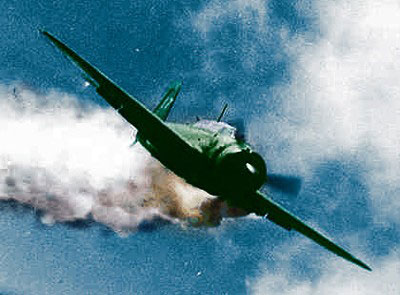
| Caption | Special attack pilot Lieutenant Yoshinori Yamaguchi's Yokosuka D4Y3 Model 33 diving at carrier Essex, at 1256 on 25 Nov 1944, photo 2 of 2 ww2dbase | |||||||||||||||
| Photographer | Unknown | |||||||||||||||
| Source | ww2dbaseUnited States Navy via Wikimedia Commons | |||||||||||||||
| Link to Source | Link | |||||||||||||||
| More on... |
| |||||||||||||||
| Photo Size | 400 x 295 pixels | |||||||||||||||
| Photos in Series | See all 3 photos in this series | |||||||||||||||
| Photos on Same Day | 25 Nov 1944 | |||||||||||||||
| Photos at Same Place | Pacific Ocean | |||||||||||||||
| Added By | C. Peter Chen | |||||||||||||||
| Licensing | Public Domain. According to the United States copyright law (United States Code, Title 17, Chapter 1, Section 105), in part, "[c]opyright protection under this title is not available for any work of the United States Government". Please contact us regarding any inaccuracies with the above information. Thank you. |
Did you enjoy this photograph or find this photograph helpful? If so, please consider supporting us on Patreon. Even $1 per month will go a long way! Thank you. Share this photograph with your friends: Stay updated with WW2DB: |
Visitor Submitted Comments
2.  Bill says:
Bill says:
2 Oct 2010 12:17:55 PM
At the end of the war, Japan still had over
10,000 aircraft. And 5,000 were modified
for Kamikaze attacks.
During the Okinawa campaign the Imperial Navy
and Army lost 1,900 aircraft in such attacks.
2,255 in combat operations,2,655 in accidents
1,000 destroyed on the ground.
Plus 3,000 Navy and 2,000 Army pilots.
HISSATSU!
Surprise attack will be successful the first
time, maybe two or three times, but what fool
would continue the same attack for ten months
-Saburo Sakai-
Imperial Japanese Navy (Ret.)
Japanese term Hissatsu meaning:
(Critical Strike)
2 Oct 2010 12:17:55 PM
At the end of the war, Japan still had over
10,000 aircraft. And 5,000 were modified
for Kamikaze attacks.
During the Okinawa campaign the Imperial Navy
and Army lost 1,900 aircraft in such attacks.
2,255 in combat operations,2,655 in accidents
1,000 destroyed on the ground.
Plus 3,000 Navy and 2,000 Army pilots.
HISSATSU!
Surprise attack will be successful the first
time, maybe two or three times, but what fool
would continue the same attack for ten months
-Saburo Sakai-
Imperial Japanese Navy (Ret.)
Japanese term Hissatsu meaning:
(Critical Strike)
All visitor submitted comments are opinions of those making the submissions and do not reflect views of WW2DB.
Search WW2DB
Modern Day Location
| WW2-Era Place Name | Pacific Ocean |
| Lat/Long | 16.2833, 123.5000 |
Random Photograph
Current Site Statistics
- » 1,150 biographies
- » 337 events
- » 43,917 timeline entries
- » 1,241 ships
- » 350 aircraft models
- » 207 vehicle models
- » 373 weapon models
- » 123 historical documents
- » 260 facilities
- » 470 book reviews
- » 28,536 photos
- » 432 maps
Famous WW2 Quote
"Among the men who fought on Iwo Jima, uncommon valor was a common virtue."Fleet Admiral Chester W. Nimitz, 16 Mar 1945
Support Us
Please consider supporting us on Patreon. Even $1 a month will go a long way. Thank you!
Or, please support us by purchasing some WW2DB merchandise at TeeSpring, Thank you!
2 Oct 2010 11:35:14 AM
Lt. Yoshinori Yamaguchi flying his Yokosuka
D4Y3 Suisei,(Judy) dive bomber into the USS Essex November 25, 1944. Aircraft number is 17.
The Judy crashed into the flight deck just
missing parked planes. Sixteen men died in the attack, along with Yamaguchi.
Yamaguchi flew from Malabacat Air Field
located in the Philippines, and was part of
the Yoshino Special Attack Corps.
Lt. Yamaguchi was among the thousands of Imperial Navy and Army pilots, who died in Kamikazes attacks.
34 US ships sunk and 368 damaged.
3,048 US sailors killed and 6,025 wounded
*note
General Information Only: